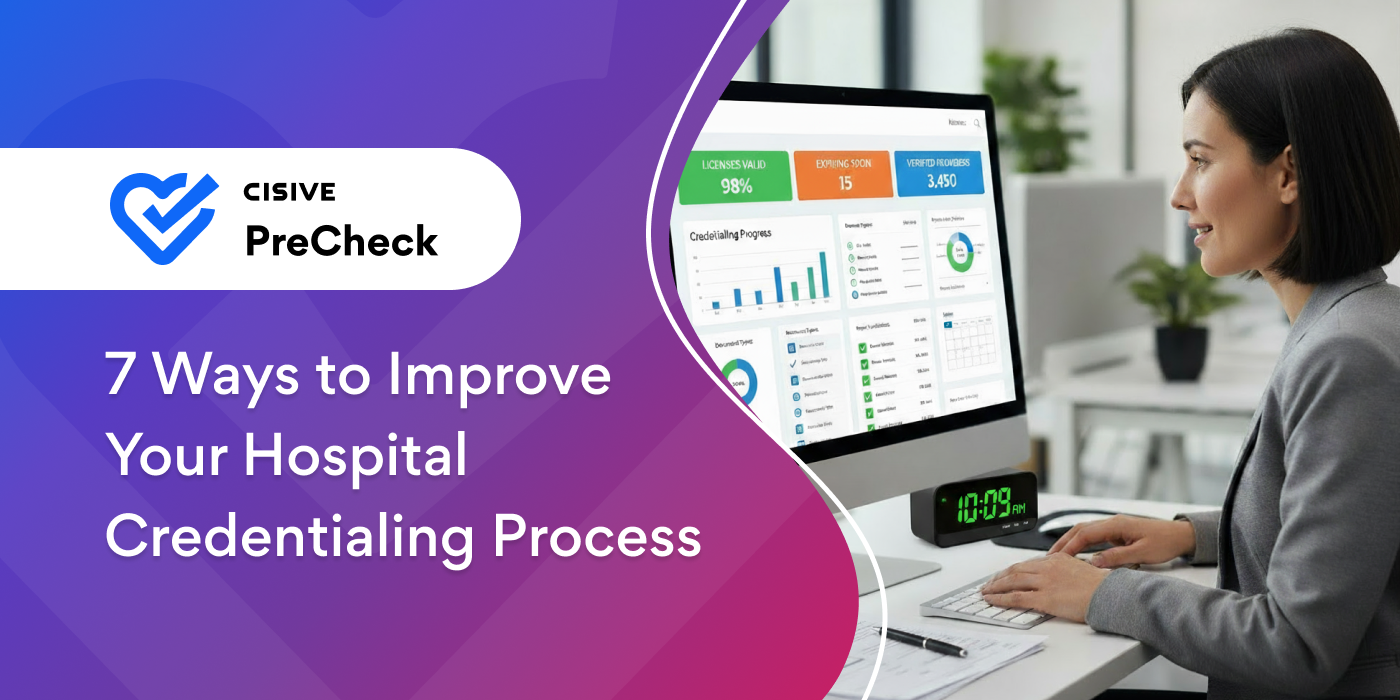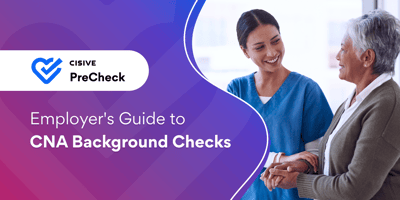

CNAs, or Certified Nursing Assistants, are the eyes, ears, and hands of patient care. Often an...

Every hospital wants only qualified, verified providers delivering patient care, which makes the hospital credentialing process non-negotiable. But working through this process can be time-consuming and convoluted — and if you’re not careful, can lead to noncompliance.
Taking shortcuts isn’t worth it. A single missing detail can delay a new physician’s start date by months, creating ripple effects for staffing, compliance, and revenue.
Fortunately, there are ways to stay compliant and on schedule. With the right structure, you can reduce delays, improve onboarding, and bring great providers into your hospital with confidence.
Key Takeaways
|

Credentialing is never simple, but hospitals face extra layers of complexity. Large provider networks, unionized staff, multiple specialties, and a high volume of locums leave little room for error.
The credentialing documentation process is lengthy. You’ll be expected to verify multiple documents, including:
Identity
Current licensure
Education
National Practitioner Data Bank (NPDB) report
Drug Enforcement Administration (DEA) registration
Life support training
Fitness of duty
Immunization and communicable disease status
Current clinical competence
Some of the most pressing challenges include incomplete or inaccurate documentation and difficulty keeping up with regulations. Each misstep can slow down hiring, but you can overcome them with the right systems. Watch out for these common challenges.
Missing or inaccurate information is one of the most common problems in credentialing. Hospital credentialing steps require complete and consistent data to move forward, meaning that gaps in CVs or misreported dates can trigger delays.
Even minor errors can stall verification for weeks, leaving clinical leaders short-staffed while HR scrambles to track down missing paperwork. Make this process smoother by choosing highly accurate, healthcare-specific solutions that understand which documents matter most.
The manual credentialing process requires contacting medical schools, residency programs, and licensing boards directly. The process can take up to six months, which translates to significant revenue loss and delays in providing patient care.
Primary source verification with state boards, universities, or specialty boards can drag on further. Expect additional slowdowns in the summertime with new residents. Many healthcare organizations still fax or mail paper forms. This can also slow down your processes and introduce opportunities for human errors.
Hospitals must track hundreds or even thousands of licenses, DEA registrations, and board certifications across staff. The duration of credentials varies, too. An MD/DO license can last decades, but a registered nurse’s license requires renewal every few years.
Without automated centralized tracking, renewals get missed. That means suspended privileges, compliance violations, unplanned schedule gaps, and cycling through this whole process all over again.
The regulatory landscape for healthcare credentialing is constantly evolving, with regular updates from various federal and state agencies, as well as accrediting bodies. Furthermore, a medical license in one state does not necessarily mean a provider can practice in another. States may have different rules for what is required during credentialing and re-credentialing. For organizations that operate in multiple states, this creates a complex web of standards to navigate.
The rules are constantly evolving, and missing even one update could put accreditation at risk. For example, telehealth licensure can have its own set of requirements.
Recruiting internationally can yield significant benefits for your healthcare organization, but cross-border credentialing can be complex. A lack of standardized information, with different formats, languages, and regulatory frameworks, make the process more time-consuming, especially if you’re working with a background check solution that doesn’t have dedicated healthcare expertise.

The steps and stages of the hospital credentialing process can feel like infinite paperwork, but missing red flags has high-stakes consequences for hospitals and their patients.
Nobody wants medical treatment from an unverified or underqualified provider. Falsified credentials are thankfully rare, but misrepresentation can lead to serious mistakes and unsafe care.
For example, if a provider’s past disciplinary action goes unnoticed, hospitals may place them in a role where they repeat those behaviors. Similarly, expired certifications in areas like infection control can directly compromise patient safety.
CMS and The Joint Commission both mandate strict credentialing standards. Hospitals that fail audits or inspections risk financial penalties, loss of participation in Medicare or Medicaid, and reputational damage. Poor processes can even lead to loss of accreditation.
Credentialing confirms a provider’s ability to bill for services, and without proper verification, your hospital might not receive reimbursement. Insurance companies routinely deny claims when credentialing isn’t properly completed. That means delayed or lost revenue, creating financial strain on already slim hospital margins.
Improperly credentialed providers expose hospitals to malpractice lawsuits. Even when clinical care is sound, plaintiffs can argue negligence in privileging. For example, if a physician begins practicing before DEA registration is confirmed, controlled substance prescribing could be flagged as noncompliant.
Identity validation matters now more than ever, and these failures are serious. A single incident can impact community trust for years, especially when it leads to patient harm. Recruitment becomes far more challenging under these circumstances.

The hospital credentialing process has a lot of moving parts, but the right structures and a good credentialing checklist help reduce risk and speed up approvals. These steps help HR and compliance leaders move from reactive problem-solving to proactive process management.
Healthcare facilities and providers both want this process to go quickly and smoothly. One of the easiest ways to speed up the process is asking providers to submit complete, accurate applications. Develop a standardized pre-application packet that clarifies what documentation to provide. This includes everything from licensure and DEA registration to malpractice insurance and continuing medical education certificates.
A checklist that highlights must-have documents can reduce the back and forth that delays start dates. Hospitals using thorough pre-application packets often have fewer incomplete files and enjoy faster committee reviews.
Many hospitals still rely on paper files and communicate through snarled email chains. This makes documents easy to lose, and these methods aren’t always secure. An ironclad digital portal creates a single source of truth for providers, HR staff, and medical staff offices.
Beyond convenience, centralization matters for compliance. Now you have an audit trail, so it’s easier to flag upcoming expirations and avoid the risk of misplaced files. Automated reminders via healthcare license monitoring can notify providers well before licenses or certifications expire. This way, you avoid coverage gaps while waiting for verification.
For roles that directly impact patient throughput, such as anesthesiologists or ICU nurses, every delay has meaningful operational and financial consequences. Running credential verification in parallel with the hiring process helps these candidates get to work as soon as the offer is finalized.
While pre-hire credentialing requires additional planning, it can shave weeks off onboarding, which greatly helps hospitals respond to staffing shortages.
Checking licenses and backgrounds for students and new hires is a good place to start, but what happens after that? Hopefully, none of your providers develop a criminal record, but you need to monitor whether any licensed staff face new charges or convictions after they’ve joined your team.
Continuous criminal monitoring protects patient and staff safety while reducing organizational liability. You don’t want a staff member practicing medicine while facing potentially disqualifying issues.
Hospitals are legally required to make sure their staff aren’t barred from Medicare or Medicaid participation. If an excluded provider slips through and continues providing patient care, that hospital can face hefty civil fines and reputational damage.
Disciplinary actions and exclusions can happen at any time, so ongoing exclusion and sanction screening matters:
OIG exclusion list: The Office of Inspector General (OIG) maintains a roster of excluded individuals and entities. Anyone on this list is excluded from working for organizations that bill Medicare or Medicaid. Exclusions can result from fraud, patient abuse, license revocation, or other misconduct.
SAM database: The System for Award Management (SAM) is a government database that tracks entities or individuals who are suspended, debarred, or excluded from federal contracts and programs. Hospitals need to check SAM to avoid employing someone barred from doing business with the federal government.
NPDB: This federal data bank maintains a clearinghouse of reports on healthcare professionals, including malpractice payments, clinical privilege actions, and disciplinary actions by licensing boards.
Internal audits give HR and compliance leaders a chance to catch issues before regulators do. Reviewing a random sample of provider files every quarter can help you spot missing documents, outdated forms, or tracking errors.
These audits also help you prepare for Joint Commission or CMS surveys. Unannounced surveys can be nerve-wracking, but if you already know what’s on file, your hospital credentialing process should hold up under scrutiny. Regular audits, whether internal or external, are necessary for compliance and help strengthen accountability.
One of the best things you can do for your hospital is to choose a background check solution that understands your unique needs. General background checks don’t capture everything hospitals need to know, whereas a healthcare-experienced partner understands the nuances of DEA verifications, license tracking, and ongoing compliance.
That’s why Cisive PreCheck specializes in healthcare credentialing support and has built a reputation as an authority:
31.8% average time-to-fill reduction in your hiring process
More than 30 years of experience in the healthcare industry
Used by 60% of the healthcare market
Industry-best 99.9994% background pull accuracy
Providers like PreCheck don’t just verify credentials once. They automate license reviews, monitor sanctions lists, keep up with drug testing and criminal checks, and centralize document management. For HR and compliance managers, that means less time chasing down paperwork. Instead, healthcare background check services help you achieve:
Faster onboarding
Reduced compliance gaps
Smoother accreditation reviews
Lower risk of claims denials
Strengthened reputation
Reduced risk of patient harm
With decades of dedicated healthcare experience, Cisive PreCheck understands the unique compliance challenges facing hospitals. PreCheck combines multiple data sources, including criminal history, license verification, and healthcare sanctions monitoring, to streamline your hospital credentialing process with industry-leading accuracy.
If you need help, responsive client support is available to help you reduce time to fill and staff with confidence. By standardizing your hospital credentialing steps and processes, centralizing data, and partnering with healthcare experts, your hospital can reduce delays, stay compliant, and ensure that only qualified providers are delivering care.
Ready to make credentialing faster, easier, and more compliant? Speak to a PreCheck expert today.
Author: Chris Bolla
Bio: Healthcare Screening Specialist at Cisive PreCheck. Husband, Dad, Coach, Hack Landscaper.
Let's Connect on LinkedIn
CNAs, or Certified Nursing Assistants, are the eyes, ears, and hands of patient care. Often an...

If your organization hires nurses, you already know the stakes: One overlooked license issue or...

Every surgery, treatment, medication, and provider hiring decision has inherent risks, from...